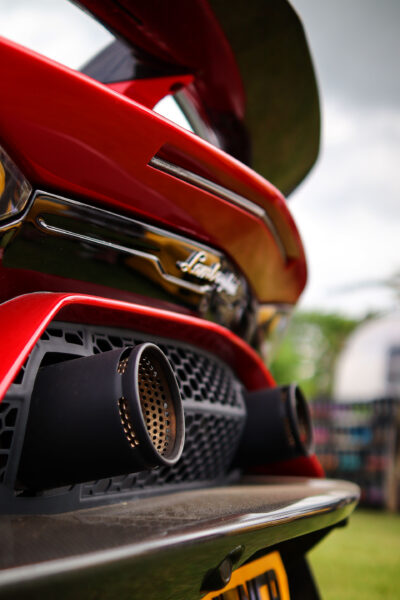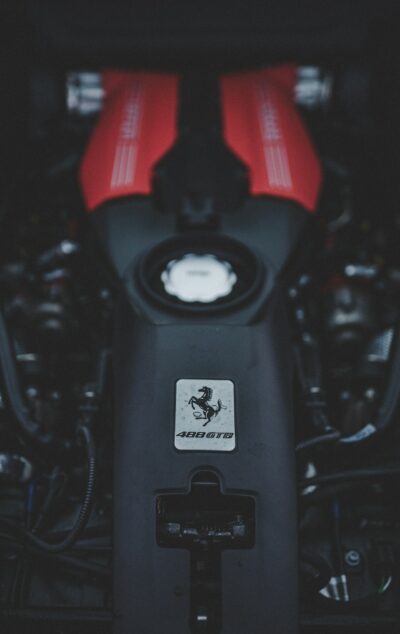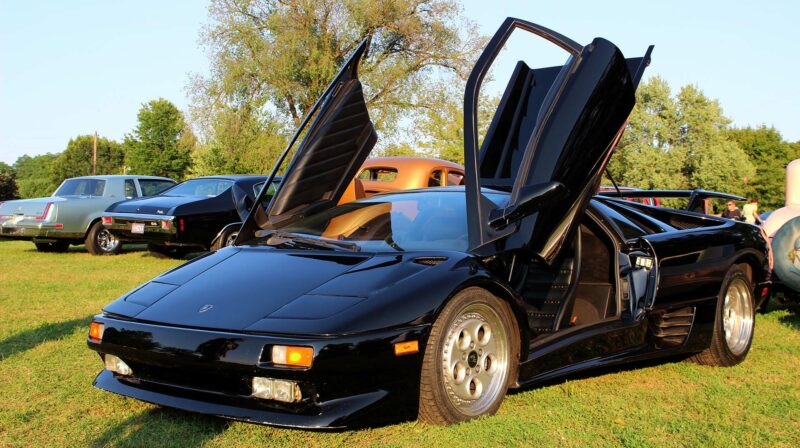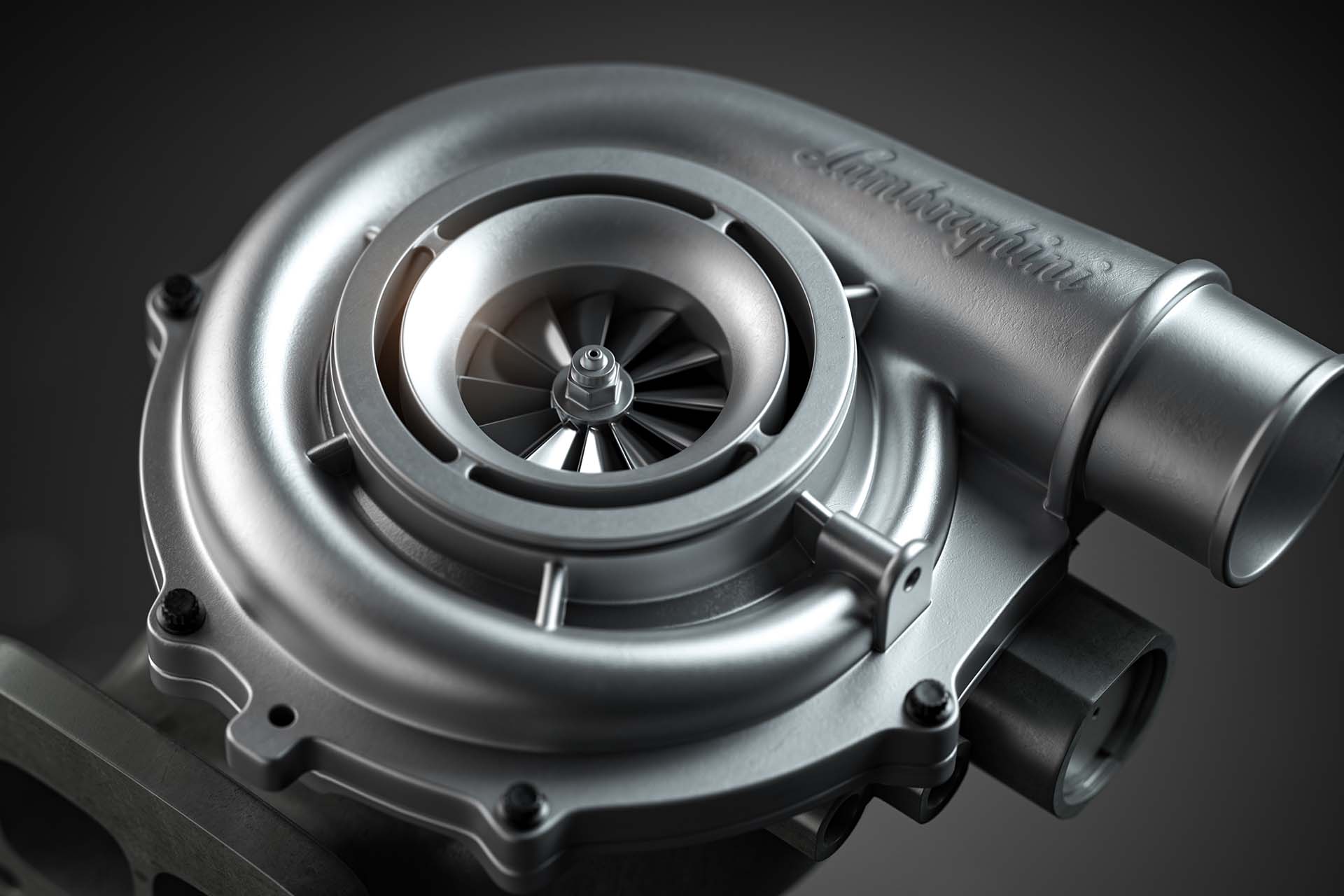The only Lamborghini model that has a turbo is the Urus.

The Lamborghini Urus has turbos attached to its 4.0L V8 engine.
The Urus is an SUV and thus is heavier and needs instant power to move that mass. The buyers of Lamborghini’s SUVs want them to be quick around town and capable offroad. Whether speeding out of a parking lot or going up a gravel hill, the engineers ensured the driver has torque available at any given moment.
Maurizio Reggiani, CTO at Lamborghini, explains that the engineering challenge of an SUV is different than a supercar.
“If you want to move a car weighing 2.2 tons on every surface, even if it’s gravel or sand, you need an engine that provides huge torque at 1,500 rpm,” Reggiani told MotorTrend. “Only a turbo can provide this. The decision to use a turbo was based on the mission of the car. Supersports cars don’t have this kind of mission.”
Turbochargers also improve fuel mileage and emissions, two things SUVs have traditionally struggled with.
Lamborghini cars do not have turbochargers.
The current Lamborghini line of cars does not feature turbochargers, and no previous car has come with turbos from the factory. The Urus SUV is the only Lamborghini with turbos.
- The Lamborghini Huracan does not have a turbo.
- The Lamborghini Aventador does not have a turbo.
- The Lamborghini hypercars (such as the Centenario, Veneno, etc.) do not have turbos.
Lamborghini avoids using turbos in their cars to maintain the best throttle response and exhaust note.

Unlike other supercar manufacturers, Lamborghini values the driving experience more than other things. Throttle response and the exhaust sound are essential aspects of the driving experience Lamborghini wants to maintain, and turbochargers dampen both.
Lamborghini wants the driver to feel completely connected to the car, and throttle response is a vital aspect of that. Touching the throttle pedal should instantaneously result in the car accelerating. Naturally aspirated engines (motors without turbochargers or superchargers) have the quickest throttle response.
A downside to turbos is turbo lag. The time between the throttle opening and the turbo spooling up to make maximum power is called turbo lag. Many improvements have been made to turbocharged engines to reduce turbo lag, but when Porche first used turbochargers in a sports car, drivers had to hit the gas mid-way through a turn so the engine would be at peak power by the end of the turn. Engineers can’t eliminate turbo lag entirely.
Turbocharger Basics
To understand why Lamborghini chooses not to use turbos in their supercars, you need to understand how a turbocharger works. The following few sections explain how a turbo adds power using exhaust gases.
A turbocharger uses exhaust gas to spin a compressor.
What is a turbo? A turbocharger, usually called a ‘turbo,’ helps an internal combustion engine create more power by forcing air into the engine. An impeller that packs air into the motor is powered by a turbine spun by the exhaust gases.
In other words, exhaust gases go into the one side of a turbo, spins up the turbine connected to a fancy fan that sucks more air into the engine, and compresses it to be burned along with fuel.
Advantages of turbos:
- More power
- Smaller / lighter engines with the same power output
- Better fuel economy (if a smaller engine)
- Reduced emissions
- Uses wasted energy
Disadvantages of turbos:
- Reduced throttle response (turbo lag)
- Muffled exhaust
- Reduced fuel economy (on a similar-sized engine)
- Mechanically complicated
- More maintenance required
- Requires other components (such as an intercooler and wastegate)
Ferrari and McLaren prefer smaller engines with turbos.

Lamborghini may not like the combination of advantages and trade-offs that turbos offer, but other exotic car manufacturers like Ferrari and McLaren have gone all-in on turbochargers.
Ferrari and McLaren (Lamborghini’s competitors) have their roots in racing. A turbocharger allows a smaller engine to make the same amount of power as a larger engine, which is excellent for racing, where every pound of weight matters.
Turbochargers also increase the pressure in the engine’s cylinders, enabling a more complete burn of the air-fuel mixture. It is easier to make a lot of horsepower while complying with emission standards with a turbocharged engine. When emissions standards became more strict in the 1980s, Ferrari chose turbochargers to comply.
Gordon Murray insisted that the McLaren F1, the first McLaren road car, be naturally aspirated for the same reasons Lamborghini prefers those engines: driver control and throttle response. But since McLaren relaunched in 2011, all of their vehicles have been turbocharged.
Lamborghini engineers challenge themselves to make power while limiting emissions without turbos.
Lamborghini with Turbo Kits
A Lamborghini supercar has never left the factory with a turbocharger, but there have been Lamborghinis with turbochargers installed. These Lambos have turbo kits: a set of all the aftermarket parts required to upgrade a naturally aspirated engine to a turbocharged engine.
Usually, these kits are not sanctioned by Lamborghini and void the 3 yr / unlimited mileage warranty the factory offers. But there was a turbo kit that was offered as a dealer-installed option.
The Lamborghini Diablo SV-TT was V12 with a dealer-installed twin-turbo kit.
In 1994, a customer could walk into a Lamborghini dealership and order a Lamborghini Diablo VT-TT. The TT stood for twin-turbo and made 750 horsepower which was 258 horsepower over the base Lamborghini Diablo VT.
The twin-turbo Diablo program was extremely limited. A Lamborghini dealership in southern California, Platinum Motors, commissioned a 3rd party to design and manufacture a twin-turbo kit. They built five Diablo VT-TTs (four-wheel drive), one Diablo SV-TT (rear-wheel drive), and a handful of other Diablo owners bought the kit and made their own twin-turbo Diablos.

It is an intriguing part of Lamborghini’s history, given the company is pretty anti-turbo. The Platinum Motors story is akin to when Yenko Chevrolet went against General Motor’s rules and found a way to order 1969 Camaros with big-block engines. The result was 201 COPO Camaros, some of the most valuable collector cars in history.
Aftermarket Turbo Kits
Third-party companies produce and install kits that enable Lamborghini owners to double or even triple the horsepower of their supercars using turbocharger systems.
For The Lamborghini Aventador
For The Lamborghini Huracán
- Boost Logic Turbo Kit
- AMS Performance Turbo Kit
- ETS Tubo Kit
- Underground Racing Turbo Kit
- Sheepey Race Turbo Kit
- Heffner Performance Turbo Kit
For The Lamborghini Murcielago
For Lamborghini Gallardo
I do not endorse or recommend any of these kits in particular. The links are for personal interest only.
None of these kits feature intercoolers, which may give us another clue as to why Lamborghini engineers do not use turbochargers. It is hard to package a complete turbo system on a mid-engined car.
So if no turbos, then what?
If Lamborghini refuses to put turbos on their cars, what can we expect in its place? Turbos help make more power and help with emissions, but Lamborghini engineers are not willing to sacrifice throttle response.
What if a newer technology improved power, emissions, and throttle response? That technology is a hybrid drive system. Maurizio Reggiani, Lamborghini’s CTO, confirmed that the successor to the Aventador will feature a naturally aspirated V12, which may be connected to a plug-in electric hybrid that fits with Lamborghini’s brand values.
“Maybe we have hybrid boost for turbo-like performance,” Reggiani told MotorTrend. “When I have a tank of energy, I want to use what is best for homologation. Once you fulfill that requirement, the additional energy can be used for performance.
“We have the anima selector, for Strada, Sport, and Corsa driving modes. In Strada, we never use the (battery) energy as a boost (perhaps using hybrid power for EV-only operation in urban centers).
“In Sport, we use the electric power in the rear axle with electronic torque vectoring to have more control. And in Corsa, we send the electric boost to the wheel that can best transfer the torque at any speed.”
The combination of a V12 gasoline engine and an electric motor could have the ultimate throttle response. The only thing with more instantaneous torque than a naturally aspirated engine is an electric motor.
A hybrid system can also improve handling. Independent electric motors can help the car turn by vectoring the torque, i.e., putting power to the outside wheels on a turn to push the car around. The placement of the batteries can also help with front / rear weight balance, which can make the most of the grip of the tires through a turn.
Conclusion
Lamborghini has such a strong heritage because they stick with their values even if it isn’t the easiest thing to do. They buck trends and stick with their guns.
Lamborghini and its loyal customers value the driving experience, and they are unwilling to compromise throttle response and the engine note. It would be easy to bolt turbos to engines and make the insane power numbers as Ferrari, Koenigsegg, and McLaren while effortlessly passing the emissions tests.
But Lamborghini learned to make tremendous power while respecting emissions standards through a naturally aspirated engine that better fits their vision. And now they have the opportunity to embrace an even newer technology that is more in line with their values: hybrid electric drive systems.

Leave a Reply